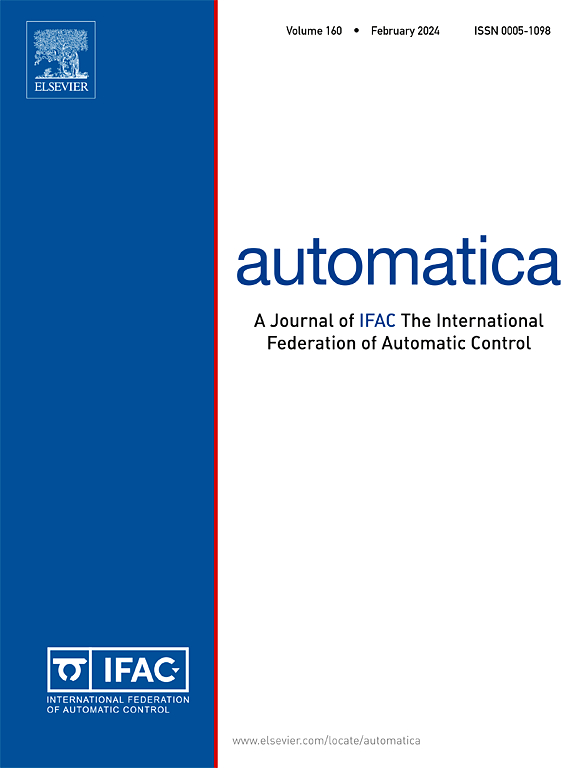Distributed adaptive fixed-time formation tracking for heterogeneous multi-agent systems
IF 5.9
2区 计算机科学
Q1 AUTOMATION & CONTROL SYSTEMS
引用次数: 0
Abstract
This article investigates the problem of fixed-time time-varying formation tracking control (FTC) for heterogeneous linear multiagent systems (MASs) under the directed communication graph. It is assumed that the Laplacian matrix associated with the communication graph is unavailable and that the system matrices of the leader are only available to its neighboring followers. This differs from many existing works on fixed-time FTC problems where the communication graphs are typically undirected and protocol designs often rely on certain global information. A novel distributed observer is first put forward to estimate both the state and system matrices of the leader in fixed time. Then, an adaptive scheme is developed to solve the time-varying regulator equations resulting from the estimated leader system matrices in fixed time. Based on the proposed observer and the adaptive solutions to the regulator equations, a distributed adaptive fixed-time FTC protocol is further proposed via coordinate transformation techniques. It is shown that our proposed controllers do not require the input matrices of the followers to be of full row rank. It is also shown that the concerned fixed-time FTC problem can be solved with the proposed fixed-time FTC strategy in a distributed manner. Our results can be directly applied to solve both the adaptive fixed-time cooperative output regulation problem and the leader-following consensus problems of MASs under the directed graph. Finally, the effectiveness of the proposed fixed-time FTC strategy is demonstrated through a numerical example.
异构多智能体系统的分布式自适应固定时间编队跟踪
研究了有向通信图下异构线性多智能体系统的定时时变编队跟踪控制问题。假设与通信图相关的拉普拉斯矩阵不可用,并且领导者的系统矩阵只对其相邻的追随者可用。这与针对固定时间FTC问题的许多现有工作不同,在固定时间FTC问题中,通信图通常是无向的,协议设计通常依赖于某些全局信息。首先提出了一种新的分布式观测器,用于在固定时间内对领导者的状态矩阵和系统矩阵进行估计。在此基础上,提出了一种自适应方案来求解在固定时间内由预估的前导系统矩阵产生的时变调节器方程。基于所提出的观测器和调节器方程的自适应解,利用坐标变换技术进一步提出了一种分布式自适应固定时间FTC协议。结果表明,所提出的控制器不要求follower的输入矩阵为满行秩。研究还表明,所提出的定时FTC策略可以以分布式的方式解决有关的定时FTC问题。研究结果可直接应用于有向图下的自适应固定时间协同产出调节问题和MASs的领导-跟随一致性问题。最后,通过数值算例验证了所提出的固定时间FTC策略的有效性。
本文章由计算机程序翻译,如有差异,请以英文原文为准。
求助全文
约1分钟内获得全文
求助全文
来源期刊

Automatica
工程技术-工程:电子与电气
CiteScore
10.70
自引率
7.80%
发文量
617
审稿时长
5 months
期刊介绍:
Automatica is a leading archival publication in the field of systems and control. The field encompasses today a broad set of areas and topics, and is thriving not only within itself but also in terms of its impact on other fields, such as communications, computers, biology, energy and economics. Since its inception in 1963, Automatica has kept abreast with the evolution of the field over the years, and has emerged as a leading publication driving the trends in the field.
After being founded in 1963, Automatica became a journal of the International Federation of Automatic Control (IFAC) in 1969. It features a characteristic blend of theoretical and applied papers of archival, lasting value, reporting cutting edge research results by authors across the globe. It features articles in distinct categories, including regular, brief and survey papers, technical communiqués, correspondence items, as well as reviews on published books of interest to the readership. It occasionally publishes special issues on emerging new topics or established mature topics of interest to a broad audience.
Automatica solicits original high-quality contributions in all the categories listed above, and in all areas of systems and control interpreted in a broad sense and evolving constantly. They may be submitted directly to a subject editor or to the Editor-in-Chief if not sure about the subject area. Editorial procedures in place assure careful, fair, and prompt handling of all submitted articles. Accepted papers appear in the journal in the shortest time feasible given production time constraints.
 求助内容:
求助内容: 应助结果提醒方式:
应助结果提醒方式:


